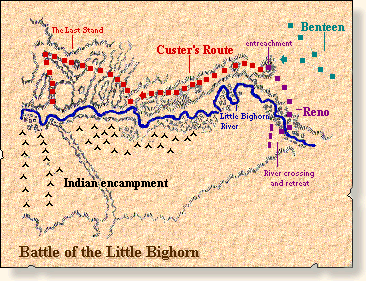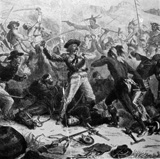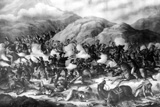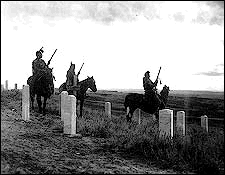|
"Custer's Last Stand" |
|||||
|
In the mid 1800s, Indians in Montana were sick and tired of living on a reservation. They bravely left their reservation and set up a village that was three miles long on the banks of the Little Bighorn River. The village was set around Sitting Bull who was a highly respected Indian chief. The United States Military wanted the Indians on a reservation so they sent soldiers under the command of Lieutenant Colonel George Armstrong Custer to drive the Indians back. The U.S.'s original plan was to have three forces under the commands of John Gibbon, George Crook, and George Custer. They were going to trap the Indians from all sides and attack. It looked like a very easy win over the Indians. No one expected the surprising outcome. By early June the three forces were riding towards the Indian's encampment. Everything was going smoothly. Then, on June 17, 1876 Crook's force ran into Crazy Horse's band of warriors at Rosebud Creek. Crook's force couldn't defeat the Indians, so they turned around. Gibbon and Custer had no idea that Crook was no longer going to make it to the battle.
Sitting Bull had a vision of a great battle that was going to take place. His vision came to him about one month before the Battle of the Little Bighorn. It told him the Indians would have a great win and a great loss as well.
Custer's force was heading towards the south end of the encampment. Indians forced them to back up onto a high ridge. They fought there for several hours. Packs of Indians kept coming at them. With their position looking desperate, Custer ordered his men to shoot their horses and position them to form a wall. The horses didn't help very much. The U.S. was outnumbered four to one and as a result, soon all 210 members of the Seventh Calvary were dead. After one more day of fighting with no news from Custer, Reno left the battle. They discovered what had happened to Custer and his soldiers which put them in total shock. |
|||||
|
When the battle was over, the Indians stripped and mutilated all of the uniformed soldiers. They believed that the soul of a mutilated body would not be able to ascend to heaven and would have to wander on Earth forever and ever. |
Site where Custer's men were buried. |
||||
|
However, they did not scalp or mutilate Custer because he was not wearing his uniform. Instead the Indian women popped his eardrums so he would hear better in his afterlife. Custer had made a promise to the Indians which said that he couldn't attack the Cheyenne and the Cheyenne couldn't attack him. They told Custer that if he broke his promise they would kill every last one of the soldiers Custer had. Still the Indians starved. Some made it to freedom in Canada while others went to live on a reservation. All of them were praying for life to improve. There are several questions about the Battle of Little Bighorn that we may never find out. Some people say Custer was a hero and others say he was too ambitious. A few people think that if Crook and Gibbon's forces would have been there the U.S. would have won. The battle was nicknamed "Custer's Last Stand" because to everyone's astonishment, Custer died in a battle that was supposed to be an easy victory. In the end, the Indians went to the reservations and the white men stayed living on the other land.
|
|||||




